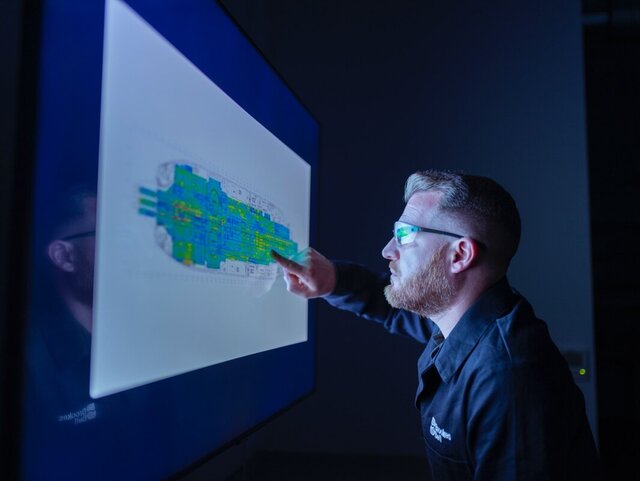Surface inspection is an important part of maintaining the condition and life span of an asset.
Used to detect discontinuities such as cracks, stresses, corrosion and more, the best surface inspection technologies will provide a true picture of the real condition of your asset.
Here at The Lab, our electromagnetic surface inspection technologies are ideal for inspecting assets such as decking, turbines, gears and tanktainers - whether that’s direct to metal or through coatings.
Eddy current array (ECA)
Eddy current array (ECA) is a natural extension of eddy current testing (ECT) that improves ECT technology by using multiplexed arrays of coils arranged in rows (instead of one or two coils).
If you have a metallic surface that needs to be inspected for corrosion, damage or wear, The Lab can help.
ECA can cover larger areas much faster and with greater sensitivity than ECT, using single scan passing to detect surface-breaking cracks as small as 0.5mm and sub-surface defects to a penetration depth of 6mm or more.
The benefits of using ECA over single-element ECT include:
- Faster inspections
- Wider coverage
- Better defect detection, characterisation and monitoring
- Simpler ECA scan patterns, enabling easier and more accurate analysis
- Improved defect positioning and sizing due to encoding of inspection data
- Easier inspection of hard-to-reach areas and complex geometries
- Fully recordable, robust data sets enabling improved decision making
- Post-inspection analysis capability
- 3D advanced imaging of defects
- Effective through coatings and paints
The Lab’s ECA technology has a number of useful applications, and can be used to inspect:
- Welding
- Corrosion in plate, pipe, casting and forgings
- Deck wear
- Turbines
- Gears
- The integrity of tank containers (tanktainers)
ECA has a range of typical detection capabilities which improve upon traditional NDT inspection methods such as magnetic particle testing (MT), liquid penetrant testing (PT) and single-element ECT.
The table below shows how ECA compares to these traditional NDT inspection methods:
| PT | MT | ECT | ECA/TECA | |
| Effective on coatings/paintings | No | Yes | Yes | Yes |
| Computerised record keeping | No | No | Partial | Yes |
| 3D/Advanced imaging | No | No | No | Yes |
| User dependence | High | High | High | Low |
| Speed | V Low | V Low | V Low | V High |
| Cleaning | No | No | No | Yes |
| Post-inspection analysis | No | No | No | Yes |
| Chemicals/consumables | Yes | Yes | No | No |
Welds - using Sharck probe (TECA) and I-Flex probe (ECA)
The Lab also has TECA and ECA probes which are specially designed to inspect certain types of weld and other surfaces.
The Sharck and I-Flex probes are able to rapidly detect harmful defects such as surface-breaking cracks in:
- Ferromagnetic and non-ferromagnetic weld materials
- Dirty, coated and abrasive surface conditions
- Various weld shapes (the probes can adapt to fit the weld crown)
Advantages:
- No surface preparation required
- Causes no damage to paint or protective coatings
- Covers the head affected zone (HAZ), tie and cap in one pass
- Accurately positions, measures and sizes cracks up to 7mm
TECA™
Tangential Eddy Current Array (TECA™) is designed to inspect carbon steel welds using the latest advanced technology - the Sharck probe by EddyFi.
Corrosion in plate, pipe, casting and forgings
By multiplexing multiple analog signals to achieve eddy current array, we are able to improve the resolution of our inspection system, making it extremely efficient at detecting many different types of corrosion on a wide range of materials:
- Pitting corrosion
- Fretting corrosion
- Stress corrosion cracking
- Surface corrosion
Turbines
Being highly critical assets that are complex and costly to shut down, it’s vital that you inspect turbines regularly.
The Lab’s ECA surface technology enables fast and accurate inspections of turbine components, including:
- Dovetails
- Blades (leading edge, gas path, root)
- Generator slots
- Retaining rings
- Rotor bores
- Boreholes
Gears
Gears are critical components both onshore and offshore in a variety of equipment such as jack-up legs, crane slew bearings, girth gears, pinions, bull gears and drive trains.
Safety and life-cycle considerations require close monitoring of each gear for surface-breaking cracks caused by stress during operation.
Use of the ECA Gear Probe saves time and money over conventional inspection techniques due to:
- Single pass crack detection
- Greater sensitivity to small surface defects than magnetic particle testing (MT), penetrant testing (PT) and ultrasonic testing (UT) because of the way eddy currents propagate inside conductive materials, such as those used in gears
- Inspection data displayed as 2D and 3D C-scans – allowing easier identification/interpretation of defects
- Recordable data, enabling better reporting
- Better and more accurate analysis capability
- Detection capability of 0.5mm for surface-breaking cracks
To find out more about The Lab at Brookes Bell’s technologies for electromagnetic surface inspections contact us now.
